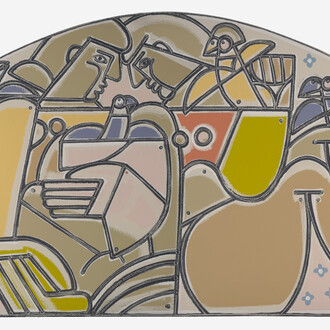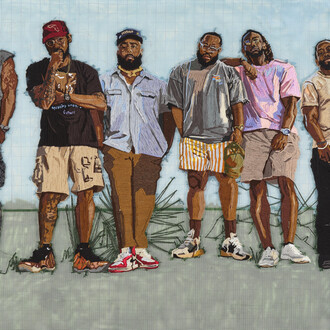In 9999, Cameron A. Granger uses the framework of video games and magic to imagine an alternative method of liberation for Black communities from the compounding effects of racist urban planning. In early role playing video games, due to low computer processing capacity, 9,999 was the numerical damage limit done to a character that could be registered on screen. Yet sometimes, additional damage continued to accrue off-screen – incapacitating, yet unseen. Granger takes this concept of the concealed yet relentless harm, and applies it to the cumulative corrosion of segregative design, environmental racism, and gentrification.
To make sense of the convoluted legacies of systemic injustice, Granger visualizes the wounds left by structural violence through “black holes” that rip the city’s fabric. His films, prints, and sculptures create a video game-like narrative that provides puzzles, tips, and charms that aid in deciphering these black holes. In diagnosing the root cause of the issue, Granger proposes that the black holes are the result of a spell cast by nefarious, hidden forces. To break the curse, he speculates what might be possible if the black holes could be used as portals to share knowledge.
Seeking answers, Granger turns to stage magicians, root workers, and conjurers. His work references Black magicians such as Henry “Box” Brown (1815-1897) whose performances alluded to his 1849 self-emancipation via mail, and Benjamin Rucker aka Black Herman (1892-1934) whose magic acts and conjuring remedies built a massive following in the 1920s among Black communities. Granger also draws on the practice of conjuring, invoking remedies for locating harm’s source, protecting, and healing. Additionally, he calls upon the Haitian folklore of zombies, originally mythologized as the spirits of enslaved laborers trapped to haunt plantations in their afterlife. Granger reconceptualizes their spirits as a unified force reemerging from the grave to aid in liberation.
Sourcing wisdom from Black forebears whose knowledge helped their communities self-emancipate, heal, and thrive, Granger offers a collective vision of empowered futurity. In a dimly lit gallery that mimics the digital landscape of a video game, Granger creates a narrative where memories of and knowledge from Black ancestors provide clues, methods, and tools that once pieced together, may reveal the key to break free.
Cameron A. Granger (b. Cleveland, OH, 1993) is an In Situ Artist Fellow at the Queens Museum. He attended Euclid, OH public schools and Skowhegan School of Painting and Sculpture. Granger has exhibited his work in solo exhibitions at No Place Gallery, Columbus, OH (2022); Ortega y Gasset Projects, Brooklyn, NY (2019), and Vox Populi, Philadelphia, PA (2018), among others. He has shown in group exhibitions at MoMA PS1, Long Island City, NY (2022), Jack Shainman The School, Kinderhook, NY (2022), and The Bemis Center for the Arts, Omaha, NE (2021), among others. Granger was an artist-in-residence at the Studio Museum in Harlem, NY (2022). His film, Before I let go, was awarded Best Experimental Film and the Audience Award at the 2023 BlackStar Film Festival. Granger’s work can be found in the collection of the Columbus Museum of Art, Columbus, OH. He is a member of MINT Collective and ACRE Residency. Granger lives and works between Columbus, OH and Queens, NY.
(Cameron A. Granger: 9999 is curated by Sarah Cho, Assistant Curator)













